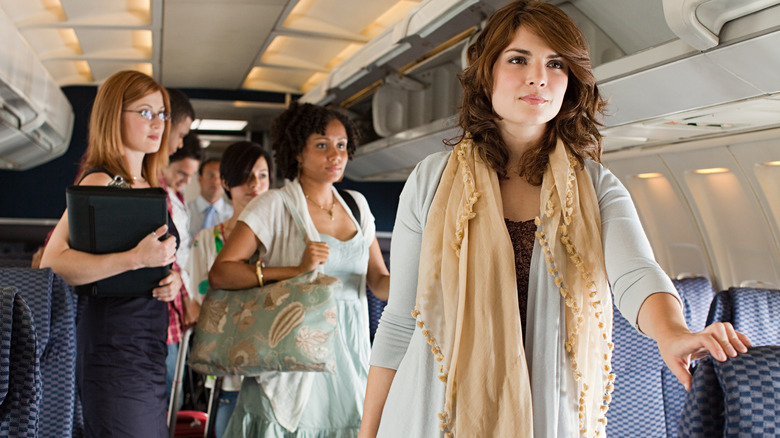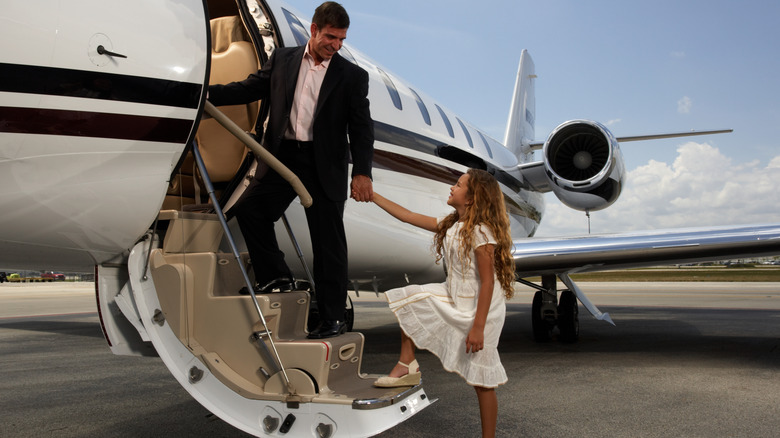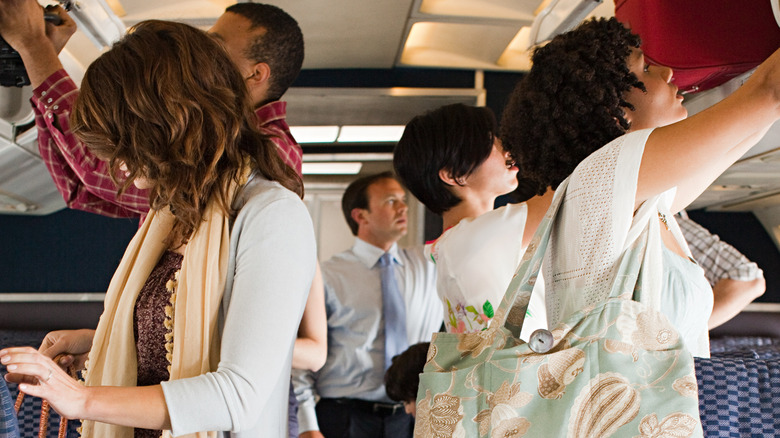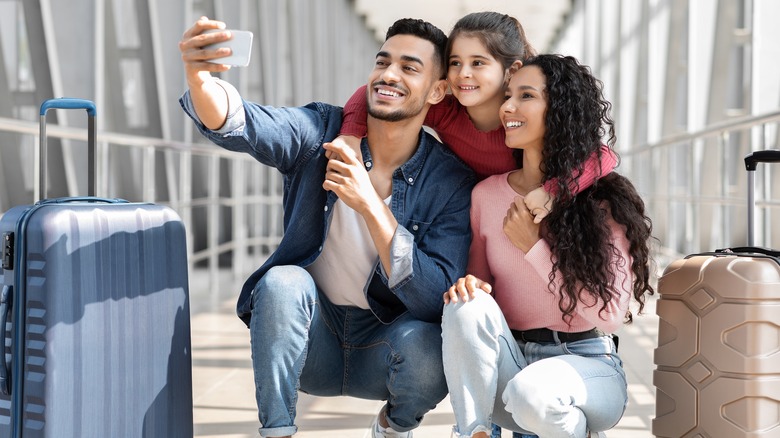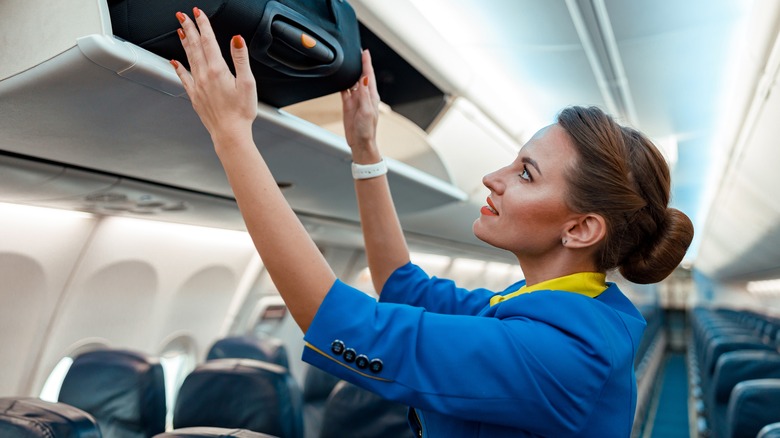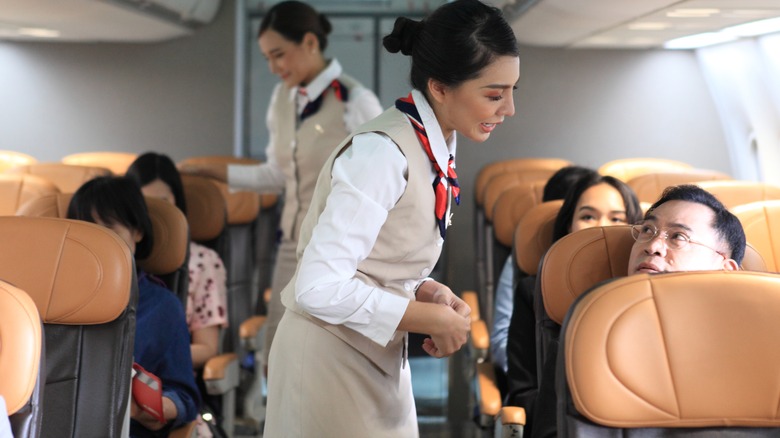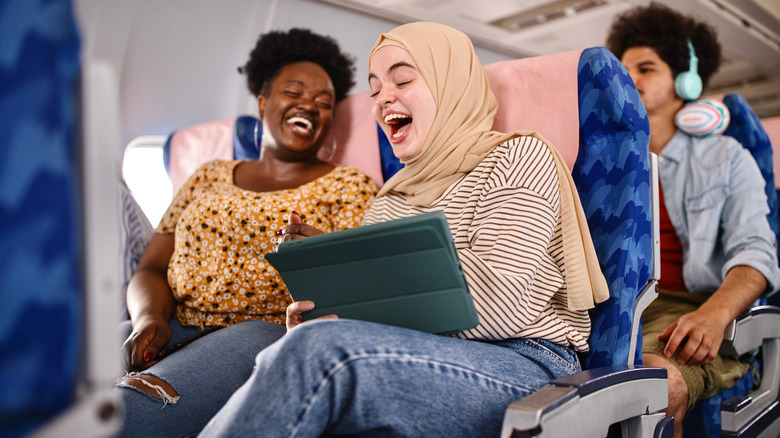Should Airlines Have Stricter Dress Codes? We're Diving Into The Debate
Dress codes are designed with visual cohesion and decorum in mind — not comfort. That's why you don't typically see dress code enforcement at play in settings where comfort is a priority. A flight is a case in point.
Air travel nowadays means leaning over the tray to get some shut-eye in a compact vehicle surrounded by strangers. This experience can be draining, which is why most airlines do not explicitly dictate what you wear — as long as it's in good taste. But taste is subjective and subject to confusion. In 2017, United Airlines sparked a furious Twitter debate after refusing to transport teenage "pass riders" in leggings because their attire didn't comply with company rules. The airline's decision didn't fly with many people.
"So what you're saying is ... women and girls should be taking their business elsewhere. Gotcha. Hey @SouthwestAir you cool with leggings?," one user tweeted. Activist Shannon Watts weighed in: "A 10-year-old girl in gray leggings. She looked normal and appropriate. Apparently @united is policing the clothing of women and girls."
Airline staffers are not fashion police, but does that mean you shouldn't dress your best when boarding an airplane? If you believe that passengers are entitled to dress as they wish, you'll be surprised to find that some believe in raising strictures on plane dress codes. It is believed that stricter dress codes can help improve plane etiquette, making the journey more pleasant for both flight attendants and travelers.
Well-dressed passengers might be more well-behaved
For the cabin crew, waiting on well-dressed passengers could make their job easier — experts believe that gussied-up people are less likely to commit aggressive or threatening behaviors. "When people dress better, they tend to behave better," says Thomas Plante, a psychology professor at Santa Clara University (via USA Today). Airline pilot Ken Schulte also feels the same way. "Well-dressed people never cause drama on a flight," Schulte tells USA Today. "You might not think pilots would notice all this, but every incident of bad behavior leads to a report to the flight deck. The troublemakers are the ones who look like they just rolled out of bed."
Even if there is no direct correlation between dressing up and being gentlemanlike, there is some empirical evidence connecting clothing and behaviors. Author of the study "The Cognitive Consequences of Formal Clothing" and professor of psychology at California State University Abraham Rutchick tells The Atlantic: "Putting on formal clothes makes us feel powerful, and that changes the basic way we see the world." In the study, Rutchick and his co-authors claim that wearing formal clothes is associated with abstract processing, which, in simplest terms, is the ability to engage in big-picture thinking rather than the nitty-gritty. To put it in an airplane context, when you look like you're worth a million dollars, you're more conscious of your social image, more inclined to exercise restraint, and less likely to get into a rage over tiny details.
Passengers might welcome the idea of a dress code
Being surrounded by smartened-up, well-behaved passengers might make everyone's ride more enjoyable. "I believe that the airlines should implement a basic dress code," says Jane Angelich, an executive coach and a frequent air traveler (via USA Today). "Air travelers would contribute to an overall pleasant and positive travel experience for themselves, the crew and their fellow passengers."
As a regular air traveler, etiquette expert Myka Meier at Beaumont Etiquette strongly recommends smartening up to travel because a well-groomed appearance, in addition to demonstrating self-respect, opens doors of opportunities. Meier tells The Points Guy: "Whether it be for business or socially, you never know who you will meet. Perhaps you'll be sitting next to your next client, your future friend or even your next date."
For travel writer Dylan Essertier, dressing your part for a flight is recommendable because it's a way of showing respect to both yourself and the cabin crew. "My mom was a flight attendant for TWA and still has her uniform, which was designed by Ralph Lauren. Growing up, we were always taught by her that travel is a privilege," says Essertier. "Whenever I get on a flight, I try to look as polished as possible. I see this as both a tribute to my mom as well as my little celebration to honor the special occasion of getting to fly to a new place."
Dressing well might score you an upgrade
If a stricter dress code can inspire passengers to behave in a manner befitting their prim and proper look, that's great news for airline staff. But what do passengers get out of that? Extra love, one might say.
In an article published on HuffPost, travel writer and AirFareWatchdog.com founder George Hobica shared an incident where his friend was upgraded from an economy seat to a first-class seat on an Air Canada flight from San Francisco to Vancouver despite having rarely flown with the airline. The reason for such preferential treatment is the man was wearing a suit, according to Hobica. "Our station manager noticed how well dressed you were and told me to upgrade you," the airline gate agent told Hobica's friend.
Air Canada is not the only airline with aesthetic-oriented employees. In another post, Hobica shares his interview with gate agents from a different airline carrier, in which he inquired about their decision-making process for last-minute passenger upgrades. And the reply was: "On an oversold flight, we can definitely move someone up to first class, and yes, the better dressed you are, the more likely you are to nab that seat. I am not going to put someone wearing flip-flops up front with our best customers." This goes to show that a little consideration of your airplane style goes a long way. If you care enough to level up your travel wardrobe, someone might level up your place in the cabin.
The problem with airline dress codes
Each airline determines its own dress code, which isn't always crystal clear, and there's no easy way for everyone to agree on what's acceptable and what's not. That's why there have been instances where passengers got kicked out of airplanes not knowing why.
Take, for example, TikTok star Jacy (@maybejacy), who posted a video captioned, "Bro I got dress coded on a Southwest flight? Are we in highschool" after being asked to cover up her corset top on a flight in 2022. In the comment section, many TikTok users showed support for Jacy saying there was nothing wrong with her outfit and agreeing that the airline staff's request was uncalled for. In the same year, actress Olivia Frances Culpo was allegedly told by American Airlines staff to cover up her sports bra before she could board the plane to Cabo San Lucas.
Showing too much skin or the shape of the body is not the only invitation to getting kicked off. In 2011, guitarist Billie Joe Armstrong was removed from a Southwest flight because he didn't pull his saggy pants up, per ABC News. Another passenger was removed from a Spirit Airlines flight in 2012 for the same reason, Daily Mail reports.
Despite the fact that most airlines don't explicitly impose a dress code for regular passengers, they obviously have a lot of leeway in enforcing suitable looks and have the right to deny service to anyone who doesn't comply with their standards.
Typical airline dress code oversights to avoid
The policies of different airlines vary in accordance with the cultural norms. Buying a flight ticket from a certain carrier means you must agree to the dress code specified in the carriage contract. You should also exercise common sense to ensure you're not breaching any implicit rule. For example, with American Airlines, your responsibility as a passenger is to "dress appropriately" and keep in mind that "bare feet or offensive clothing aren't allowed."
"On Qatar Airways," says Intan, a former flight attendant with Jetstar International Airways and Qatar Airways (via Matador Network), "the dress code is a little stricter, as the mid-point is a conservative Muslim country. Some passengers may want to visit Doha as a stopover, but they must observe the strict dress codes — no sleeveless shirts, and pants must be no higher than your knees." Outfits emblazoned with vulgarities or those that reveal excessive skin might also get you booted off the plane. The same can be assumed with Saudi Arabia Airlines. In a 2018 article published in Forbes, travel writer Jordan Bishop talked about being denied boarding the national carrier of Saudi Arabia because he was wearing shorts.
If you're flying with Southwest flight, you might be turned away if the clothes that you wear are deemed "lewd, obscene, or patently offensive." Meanwhile, Delta Air Lines may refuse to transport passengers "when the passenger's "conduct, attire, hygiene or odor creates an unreasonable risk of offense or annoyance to other passengers."
What airline dress code should look like
Airlines and passengers clearly have quite different notions about what is proper and what is a visual affront to common decency, though we know the items that increase our chances of getting escorted off an airplane. Things that read vulgarities, see-through outfits, or scanty items such as sports bras, crop tops, torn shorts, and butt-revealing pants are typically off-limits. That leaves us with business casual: collared or button-down shirts, large sweaters, blouses, blazers, and long skirts and pants. When in doubt, always keep a large hoodie or a jacket handy so you have something to cover yourself up with on short notice.
Yet subjectivity is still a problem with airline dress codes because it allows for confusion and disagreement. If their goal is to promote better flying etiquette, airlines should focus on clarifying their codes. Instead of using ambiguous terminology like "lewd" or "offensive," airlines might as well give their expectations a name: "dressy casual," "semi-formal," or "black tie." Dress codes should exist to set the bar for common decency and safety across the aviation sector, but they should be explained and justified in no uncertain terms. Passengers are probably more likely to endorse and adhere to the code if they are aware of its rationale.
